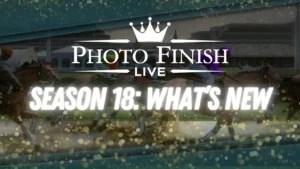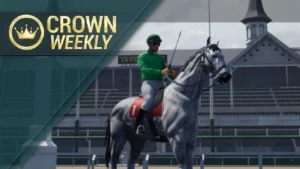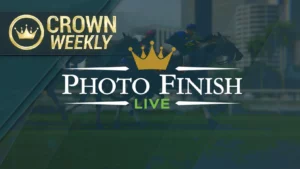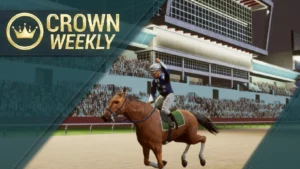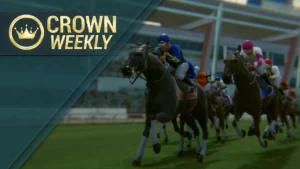GUEST POST BY “THE COMMISH” – THE CONTENTS WITHIN ARE NOT GUARANTEED TO REFLECT THE OPINION OF THE THIRD TIME STAFF
Philosophy, an intellectual pursuit appreciated by the Commish, is extraordinarily relevant to this conversation. It requires critical thinking, logical reasoning, the evaluation of complex ideas and, ultimately, problem solving techniques.
“The only true wisdom is in knowing you know nothing” — Socrates
This article will attempt to elevate us out of nothing and into something.
To know what the outcomes ought to be, one must know the full spectrum of problems or questions that exist. Otherwise, how can one decipher what action needs to occur?
In the context of Photo Finish™ LIVE… this article will try to outline as many known unknowns as possible and walk through potential solutions that one can employ as they embark on their journey through this awesome virtual horse racing ecosystem.
Adopting the perspective of a Filly owner, the narrative of this article revolves around that vantage point. However, there will be topics that cover multiple perspectives. Be aware of this changing dynamic.
Considering there is an abundance of information we do not and will never have access to, the Commish reserves the right to be wrong regarding anything published below.

The horses have finite lifespans, dying off somewhere in the 22–25 range.
Lifespan:
-Age 0–1: Foal — Firm 2 seasons (just looks cute in your stable)
-Age 2–8: Racer— Potentially up to 7 seasons (forced retirement at 9yo)
— Horses are able to retire at Age 3 and move to Retirement earlier
-Age 9+: Retired — Potentially up to 22 seasons (can start earlier)
In order to navigate the ecosystem and create a horse racing dynasty, the dedication of years will be essential, as it will require evolving competitive strategies, networking, proper financial management, patience and the excellent execution of tactics. Read that again, and again, because those components will be prerequisites for victory. During that time, as you are chasing glory and feeding your ego, it will be imperative to transfer the value of your horses to its offspring. Maintaining your leverage in the ecosystem will be critical for success, otherwise, your assets and influence will eventually depreciate to zero.
What is this value that needs to be transferred you speak of? Please define!
Value (or valuable):
1. Ability to command breeding fees (Stallions)
2. Ability to race/stud/sell the next generation of racers/breeders (Mares)
3. Ability to race and win purses (Colts & Filles)
All 3 of those considerations contain value because they can be monetized. Without the monetization aspect, this article does not exist. The rest of this article will position every consideration with the same goal… to make as much money as possible by spending as little as possible.
Yes, having fun should be at the top of the list, but making money while having fun… is the MOST fun. Therefore, in the Commish’s opinion, the 3 points listed above are deliberately in that order, ranking the best options to optimize your ROI strategy. Elite stud owners (at all grades) will dominate the ROI leaderboards because of breeding, not because of racing. Elite filly owners will try their damnedest to make elite studs and usurp that ROI either via breeding rights or selling foals. Ultimately, in the Commish’s opinion, racing is just marketing for breeding. The Solanaut Stables team are believers that if you are down or break even in racing, but have the ability to capitalize on a revenue generating asset, such as an elite colt, you are winning the game (making money). Simple math will prove this to be true.
Dinga (The Solanaut Stables Chief Racing Officer and HRM Legend) ran the most profitable fake money racing team in Beta v2 (+3M $DERBY), but it paled in comparison to the fake money breeding revenue generation that top tier colts can command (+100M $DERBY). These results pictured below took ~15 seasons to accomplish. Although Beta was funny money, the same principles will hold true with real money.
Selling breeding covers is the holy grail of PFL.
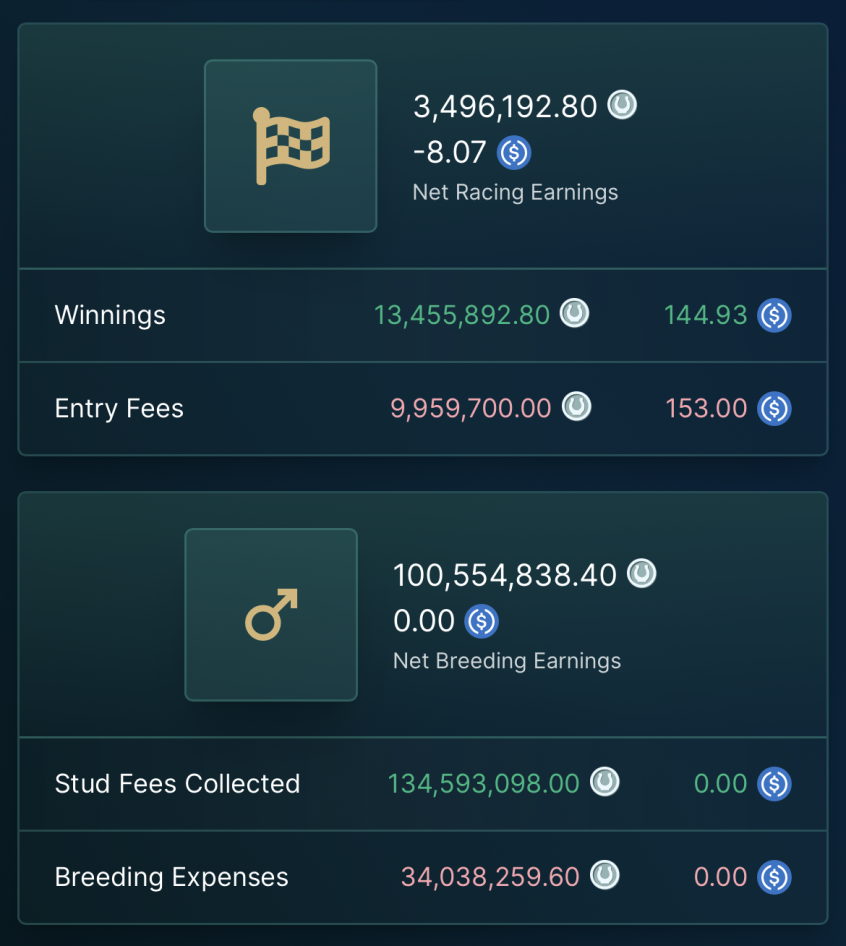
If passive income is your goal, then there are no better options than having a colt to earn you income every season.
If you choose not to breed, then the value capture proposition will diminish as your horses will become unable to race any longer and you will miss opportunities to create a new, potentially valuable asset (a foal!). Will not explore these options because it’s a waste of time to discuss guaranteed EV- strategies.
To summarize the value proposition of breeding: It allows filly owners to transfer the value of their asset into additional assets and it allows stud owners to monetize their assets.
This flywheel (coupled with $Crown) will be the engine of the ecosystem, the main source of revenue for Third Time and the most fun part about the game. All incentives are aligned. The feature of genetics based breeding is that these new assets have the potential to become more valuable than the existing asset. This probability of ‘hope’ is what does and will continue to make this game so addicting.
Imagine owning a decent mare who was underwhelming on the racetrack, but is an amazing mother and creates the next great Secretariat. Talk about maximizing your opportunity!
One more philosophical thought: Even if you can’t make an elite asset immediately within the next generation of foals… perhaps you can in the following generation(s). Every horse is a stepping stone to your destination. Do not underestimate any single horse in your barn. Good practice is to always possess a multi-generational view and plan strategically, do not just think about what happens tomorrow. Balance tomorrow with next year.
Here is a video interview with Ian Cummings on the latest breeding news. Shout out to MJ Gaming for hosting the Q&A.
What makes a great horse?
This is subjective, so let’s keep it short and sweet:
Stars (Preferences) are on the same scale for every horse in the ecosystem, therefore, keeping it as simple as possible… the more stars the better. This should be considered the foundation of your horse. A strong foundation for a house is also necessary for a horse. In a few years, the best horses in most grades will have max stars, so start chasing them now and get ahead of the curve!
Skills (Stats) are currently determined by a letter Grade which is a short hand version of defining a particular range of skill. As we know, A is better (faster) than B. When skill strengths are in a linked sequence, great horses emerge. What is ‘the linked sequence?’ It is illustrated when a horse’s best skills are adjacent (linked) to each other. Using this formation: Start-Speed-Stamina-Finish. Examples are when a horse has Start & Speed (sprinters) as its best skills, or Stamina and Finish (stayers). An ‘unlinked sequence’ would be when a horse’s best skills are Start and Finish.
Start & Speed Sequencing (Short Distance Preference: 4–7 Furlongs):
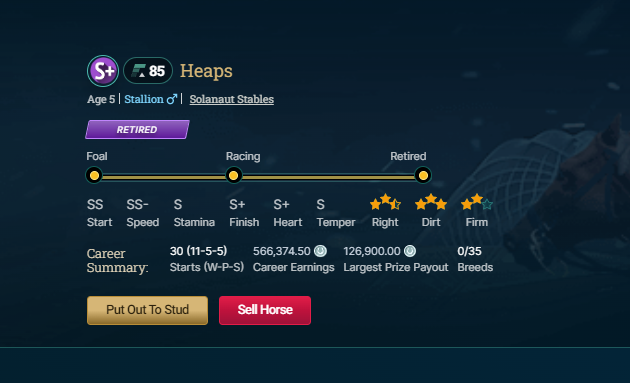
Speed & Stamina Sequencing (Mid Distance Preference: 6–9 Furlongs):
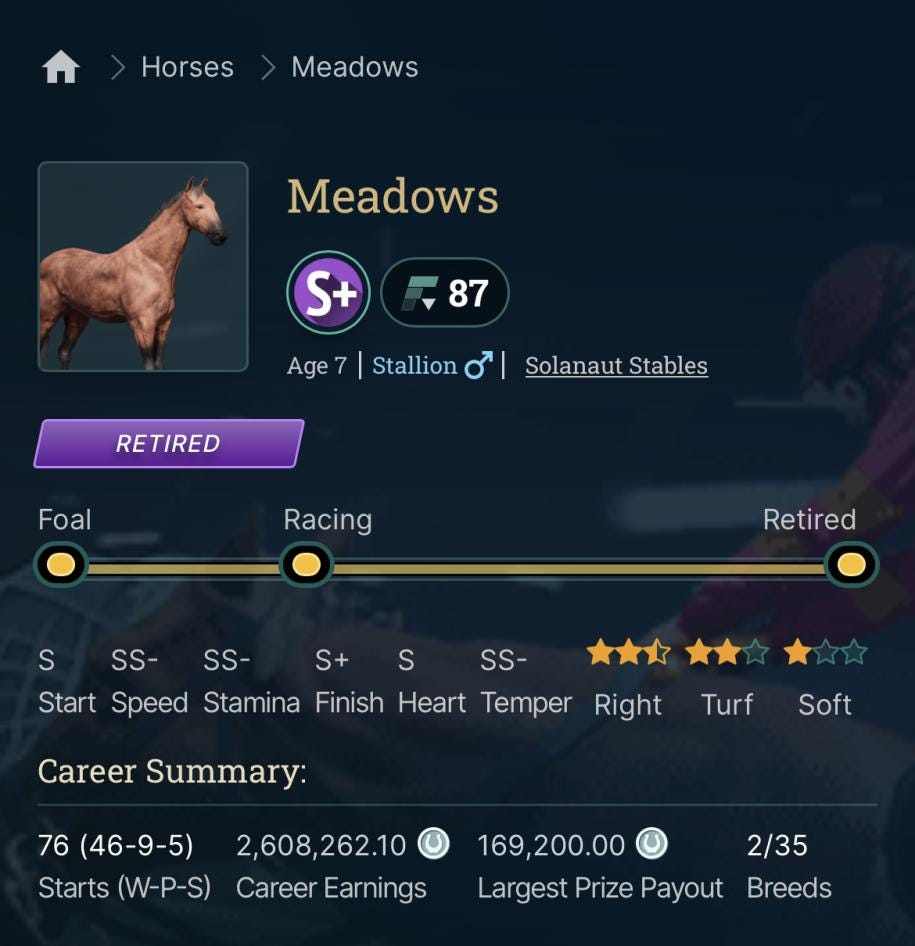
Stamina and Finish Sequencing (Long Distance Preference 9–12 Furlongs):

What’s interesting above is that Zipping (S) and Meadows (S+) were siblings (Churro & Diva parents) yet their grades, distance preferences and stars were different from each other. We saw a lot of variance like this when smashing the same parents together multiple times. At least early on, it might be a bit difficult to dial in distance preference for your foals, but maybe as generations go by, that becomes easier. To summarize, just because you breed two mid distance preference horses together, does not guarantee that the foal will prefer mid distance. Lastly, Heaps was a grandson of Prime Time (mother side) and Tony Rigatoni (father side). Elite colts with elite bloodlines make elite foals.
Can not reiterate this enough… your first breed may not always be your best breed. Be patient, because 2, 3, 4, 5 breeds in a row will produce a unique colt or filly every time. Some will definitely be better than others.
So during breeding, you will want to find studs that contain a strong foundation (Stars) and superior sequencing of stats, that ALSO align to your Mare’s sequencing of stats. Increasing your probability of success comes from putting yourself in position to make the best foal as possible, as rare/unique as possible and as often as possible.
What we THINK we know about breeding results (from Beta experience):
‘Foals are the average of the parents… with a twist’ — The Commish
This ‘twist’ gets more pronounced as we move through season after season of breeding. The prior statement is generally appropriate for Gen 0 breeding, but as the game plows through generations… this statement may easily become obsolete.
Generally, the Stars are closer to predictable… if you put 2 horses together, one with 8 stars and one with 6 stars, you will, more often than not, generate a horse with 7 stars. Sometimes you’ll get lucky (7.5 or more) and sometimes you’ll get unlucky (6.5 or less). At the moment, the frequency is unknown how often the results fall outside the 50/50 range, but it’s something data crunchers should keep an eye on as we progress through breeding seasons. It is also unknown what criteria is required to trigger this type of event… lots of matches? specific number of matches? breed sequencing (ie. every 7th breed)? Certain grandparents? Specific genetic sequencing? Luck? As we get more data, we should be trying to unpack this and understand it further.
If you drill down further and just look at Soft/Firm as an example… 3 Soft horse bred with a 3 Firm horse will likely result in a 0 star condition preference horse. The average. That might be desirable, that might not be, just depends on your goals and time horizons.
As for how grades could be distributed… your best bet is to read the blog straight from the team:
–https://thirdtimegames.com/pfl-inside-track-genes-matches/
–https://thirdtimegames.com/pfl-inside-track-part-2-gen-0-traits/
–https://thirdtimegames.com/pfl-inside-track-part-3/
This is where the leveling up (and down) takes place the most, if both parents have more breeding variance, the higher the probability of churning out a better horse, but also the likelihood of churning out a worse horse.
The closer the gap in the skills, the less grade variance the foal will have. The more variance in skills (B versus S+), the more variance the foal will have.
Some people argue that large grade gaps between breeding partners is terrible, but we categorically disagree. If there are grade restricted races… and an A- horse has Start and Speed at S and Stamina and Finish at C, that is a phenomenal opportunity to dominate the A- sprint races. The rules are the rules… don’t complain about them, use them to your advantage!
Always be ready to pivot based on the types of races being offered. Assess the competition and look for weaknesses that you can exploit. Bob when they weave. Zig when they zag.
Smashing the best colt and best filly together is not a guaranteed success. Just like in real life, not every breed is going to be a winner. Michael Jordan’s kids were not that great at basketball. Dell Curry was a good basketball player, but one of his sons is one of the best ever. All sorts of variations should be expected, so do not be discouraged if your breed wasn’t as good as you wanted it to be, might want to try again… and then maybe again… and then maybe again… and then maybe again 5 seasons later, you know… rekindle an old flame.
The 3 most important questions you need to ask yourself:
-Where do I want to compete?
-What are my Mares weaknesses?
-How much money do I want to spend?
The answer to these questions will determine which pool of Stud partners you should be researching.
Where do you want to compete?
If you are a competitor in the Graded stakes ecosystem, there is likely minimal/no benefit to breeding with Bs and As… Competing at the highest levels has a game within the game… and that is to always breed the highest graded horse possible. Why? Winning the biggest races… capturing potential stud fees or, as a Mare owner, making the next level up of foals that you can race/sell.
What are my Mares weaknesses?
Does she have less than ideal Stars? Looking for more Temper and consistency? Look for partners that can fill in those gaps, as you will be able to see all retired horses’s skills. The next best thing you can evaluate… look at the success of their Progeny… are they making successful foals? If so, that’s probably blood you want. If you are Lollis Legend, you have no weaknesses, so you have all the options you want. This is the goal, to create fillies that look like her.
What’s my budget?
Finding the diamonds in the rough, the underpriced colts that make great foals is going to be one of the best skills in the game. If you can maximize your ROI with lower costs, then you will be way ahead of the game. But that only happens when a breeder doesn’t know the value of the horses that they will produce. Capitalize early because the market is full of asymmetrical information right now. The first few seasons will likely have severely mispriced breed offerings. In both directions, too cheap and too expensive. Dusters will overpay for dogs and savvy owners will underpay for winners.
Which one will you be?
Simple Breeding Technique — Same Preference Structure:
Have an RDF filly? Find an RDF colt. Simple.
This path forward will reinforce the foundation and allow you to stay competitive every generation. This is especially important in the race types with the highest populations. Take handicaps as the benchmark… anecdotally, horses with 7+ stars win these races… so if you are competing with an A grade horse and your foundation is not 7+ stars, it will be extremely difficult to be competitive. It will take time and investment to switch preferences into other archetypes with horses that are likely 8.5+ stars by the time you are ready to compete.
For lower-mid graded horses, the Commish would definitely recommend just picking a lane and building your dynasty there.
Some considerations for simple breeding techniques:
-Same preference structure, 8+ star colts
-Uniqueness / Lower cover amounts in the early generations
— — Want to avoid in-breeding in Gen3/4/5, it will be harder than you think — High Prime Time Factor (PTF) (Win Rate x Wins)
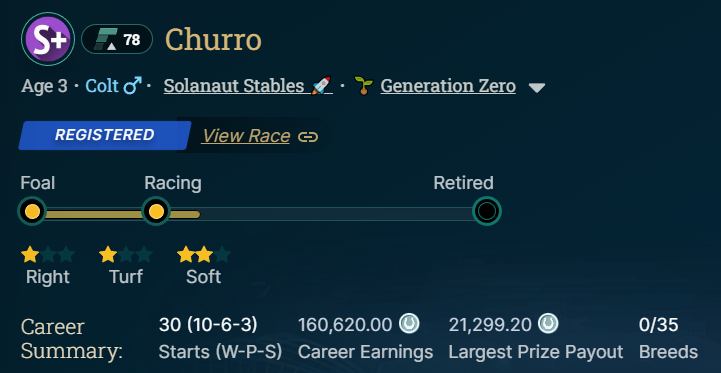
Ex: Churro has 10 wins in 30 races = 33.3% win rate x 10 wins = 3.3 PTF
The higher the PTF the better. Highlights win efficiency relative to volume. Why only wins? That’s what we are here for… to WIN, not to get 3rd.
Currently, the best place to compare Studs available on the market would be utilizing the Stud Finder app written by Gavone and Padraic, a couple of legends. They have all the data you could want, including the PTF results defined above.
Advanced Breeding Technique — Changing Preference Structure:
At the highest levels of competition, there is a lot of flexibility in breeding lines because there is a tremendous amount of Grade upside and the foundations are weaker… the inverse of the lower graded horses. You can see this from the photos posted above… non of the best horses at the highest grades have max Stars.
There are gaps at the top over the next few generations so some seriously savvy breeding maneuvers can unlock value capture if you play it correctly. Especially in LTS where basically every S filly will have to ‘breed down’ at some point because genetic diversity barely exists. One way to do that is to inject cross preference blood into your preference structure. Who can do that for you?
You’ll want Churro or Prime Time blood to accomplish this and let me show you why…
Want to move your family tree from RDF to LDF efficiently? This is a proven model that can be done efficiently and cost effectively within just 2 generations if done correctly and the foal roll Gods are on your side…
The type of horse you will need to accomplish this is what we call a “Pivot.” A Pivot must be a filly, otherwise this will not work as effectively.
Let’s take the big gun AK-47 from Miami Nation RT Stables, she is a BEAST! Max Stars in the beautiful RTF archetype 3/3/3 and a filly.

Let’s say they decide to breed AK-47 RTF 3/3/3 with Prime Time RDF 3/3/3. If they were fortunate enough to get a filly, that would be step 1 and then if the preferences spit out the average 3/0/3 (T and D would cancel out), they would be in a perfect “Pivot” position. Now, the new filly could breed with both RDF and RTF colts and they can pivot the bloodline based on the best colts available in the stud market. 2 preferences for the price of 1!
Using the Pivots in a track condition crossover (ie. 3/3/3 to a 3/3/0) is the most ideal scenario because you should still be able to race competitively (find Yielding races) and now able to breed to 2 different prefs, but Pivoting with Turns and Track preferences might mean you’ll need to skip a generation of racing. Just depends how strong the grades are at this point.
You do not need 3/3/3 Star horses to accomplish this, there are plenty of variations… however, the 3/3/3’s strengthen the other 2 prefs to the top while you lose value on 1. The best colts in the game at this are 3/3/3 max stars (Prime Time, Eclipse, Balloon Arch, etc.) and would expect them to command Pivot demand outside of their preference archetype. The focus should be to just change 1 preference at a time. This is how you capture optimal efficiency.
Now imagine you are at the top of the LTS archetype, it’s basically 2 bloodlines… You could breed with Churro and his low R won’t hurt you that much and you get the highest grades possible.
Now imagine you are at the top of the RDS archetype, it’s Doc Holliday and not much else… You could breed with Churro and his low T(urf, not Testosterone) won’t hurt your D(irt, not…) that much and you still get the benefit of R and S in your preferences. Great way to pivot and build genetic diversity, even if its not maximum efficiency (sometimes it doesnt exist). The pioneers who take these risks will be rewarded. We know because we did it in the Betas and can verify it works very well. And… we were not the only ones to do this.
In our opinion, if you are chasing bloodline diversity in LDF, RDF, RTF and RDS, there is ZERO reason why you should not consider Prime Time as an elite option for your bloodline. Those 4 are only 0 or 1 preference away.
Also in our opinion, if you are chasing bloodline diversity in RTS, RTF, RDS and LTS, there is ZERO reason why you should not consider Churro as an elite option for your bloodline. Those 4 are only 0 or 1 preference away.
Prime Time (4 trait matches — elite) and Churro (5 trait matches — grail) have the most potent and successful blood in the game… and it’s not close. Leveling up runs through them. Don’t get left behind.
And one of the most interesting cases is Tony Rigatoni, who has 0/0/0 preferences, but was a phenomenal grandparent in Beta v2 breeding. He didn’t make the best Gen1 racers, but some of his Gen1 offspring were fantastic breeders. If you want to become a breeder, it would be wise to go after his blood. We suspect those who go for Tony’s grade upside and minimal preference pain will be in a great position to capitalize on their own breeding revenue. Tony is unique genetic diversity in a number of preferences, we can’t wait to see what he churns out.
Advanced Breeding Technique — Building LTF:
Don’t do it… Just kidding.
This will be extremely time consuming and require a significant amount of foal roll luck. However, the first person to make a 7+ Star LTF Colt should win the breeding game and crank out a number of breeds as this archetype wants to fill in the gaps.
The best starting horse (close to a Pivot) in the Commish’s opinion is one of SOLmate’s fine fillies: Black Grass
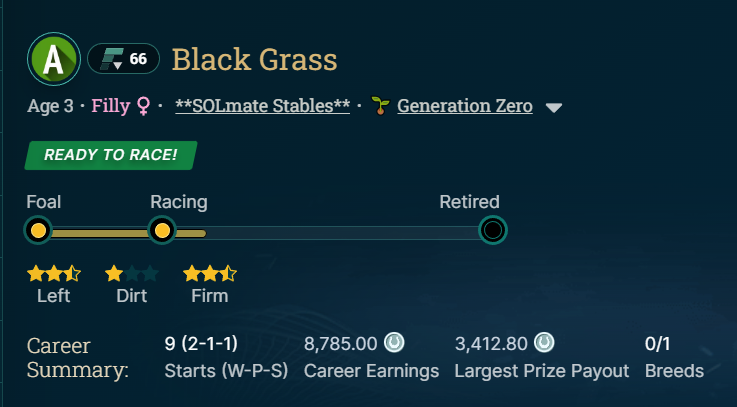
He has many different ways to do this, but he’ll want a strong LT colt who is weak in S. Strengthen the L, flip the D to a T and not crush the F. There are plenty of colts that can accomplish this.
He already knows this, and he will probably do it. But we are highlighting this strategy so you can also see how it can be done in 1 generation. Now, staying in LTF multiple generations is another story, but it can be done for Gen 1.
Advanced Breeding Technique — In-Breeding:
When purchasing or breeding horses, it is imperative to review the genetics of the horses. Click on the Bloodline tab within a horse’s profile:
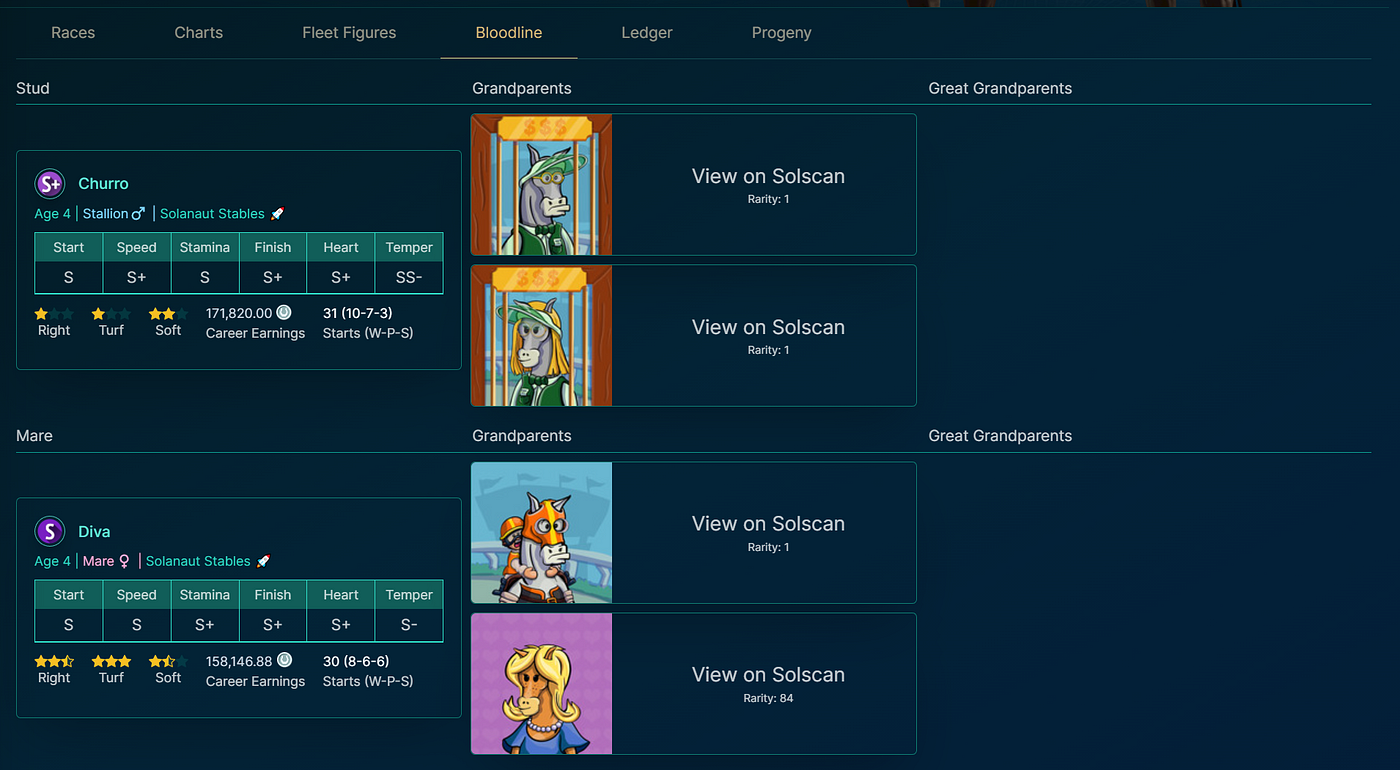
You will need to avoid having any repeats in your bloodlines, otherwise the foal will contain undesirable genetics and penalized, to some degree, on the strength of the skills it possesses. At the time of this writing, there is no known penalty to a foal’s preferences whose parents were in-breeding.
Now it seems obvious that to get to your destination the quickest, you will want to avoid in-breeding, but we are here to offer a counter point as well.
Let’s just say from the above picture, a filly foal is produced… what happens if breeds back to Churro, or to another Ticket Window stud… well, we don’t know exactly… yet. However, those who navigate the in-breeding waters might uncover some patterns that could potentially unlock some new racing strategies. For example, if the only penalty is just a flat reduction across the board in terms of skills, but a boost in preferences… maybe that could fit the ‘1 step back to take 2 steps forward’ philosophy, or ‘you have to break an egg to make an omelet’ proverb.
Higher preferences, but lower graded result might benefit you in handicaps or allowances, even if it means sacrificing competing in the graded stakes for this generation.
Now, does an in-bred foal carry breeding penalties into the future? Unclear.
This approach is all speculation, but certainly something to keep an eye on if you like operating in counter culture and want to take a different path than most. We could absolutely see a scenario where someone benefits from an in-bred horse and to be honest… we are cheering it on. The more unique strategies and tactics the community deploys, the more fun this thing becomes, the more topics we get to discuss, etc…
People love novelty, a successful in-bred horse will certainly steal the show.
Becoming a Breeder (Seller side):
If you have decided to take on the role of a breeder (who sells foals), there are a few key considerations to keep in mind. Maximizing your profits requires careful planning and strategic decision making.
You may want to offer lump sum payments to buy successful colts and ‘buy out’ their ability to breed, believing you can make more money breeding that colt than the price you paid for him. The seller is taking instant liquidity at a discount, while the breeder/buyer (eventually becoming the seller) sees more upside than the price paid. This game theory is going to be really fun to watch play out.
For example, someone may offer the Commish $500,000 for Prime Time, thinking they could earn $1,000,000 in stud fees over his lifetime, would the Commish take $500,000 now in exchange for the longer term upside of what breeding *could* generate? Is the risk worth it? This dynamic will play out… you know why? Because some people like liquidity and some people like passive income. Another awesome game within the game. This scenario will be very similar to winning the lottery, do you want a guaranteed payout at a discount (Breeder pays you)? Or do you want to take the annuity payments and hope they last as long as possible? Lots of fun here.
The quality of your foals plays a significant role in their market value. Breeding horses with desirable traits and strong bloodlines increases the likelihood of making a sale. Potential buyers are willing to pay a premium for foals with exceptional skills and stars. Invest in top-notch studs and carefully select mates for your mares to enhance the value of your foals.
Additionally, reputation will absolutely matter in the community. Building a positive reputation as a breeder who consistently produces successful foals can significantly increase the demand for your horses. Establishing connections with other constituents can open doors to more lucrative opportunities. Networking and showcasing your achievements can help attract potential buyers and increase your chances of selling foals at higher prices.
Marketing your foals effectively is another critical aspect of becoming a successful breeder. Utilize various platforms and channels to promote your horses to a wide audience. Highlight their strengths, such as exceptional skills, stars, bloodlines or race results to capture the attention of potential buyers. Engage with the community.
Remember that breeding and selling horses is a long-term investment. It requires patience, persistence, and continuous improvement. Learn from your experiences, adapt your strategies, and stay updated with the latest trends in the ecosystem. The more you refine your breeding techniques and establish yourself as a reputable breeder, the higher your chances of achieving financial success in this virtual horse racing world.
Our favorite Colts to keep an eye on:
Our 3 favorite Colts for each archetype at the top of the Gen0 game that you just HAVE to get at least one breed with. Must haves. Can’t wait to see how they do in the breeding barn. Some special unique pieces here. Do not under estimate rarity, especially at the top of the ecosystem.
(Prime Time Factors as of June 25, 2023):
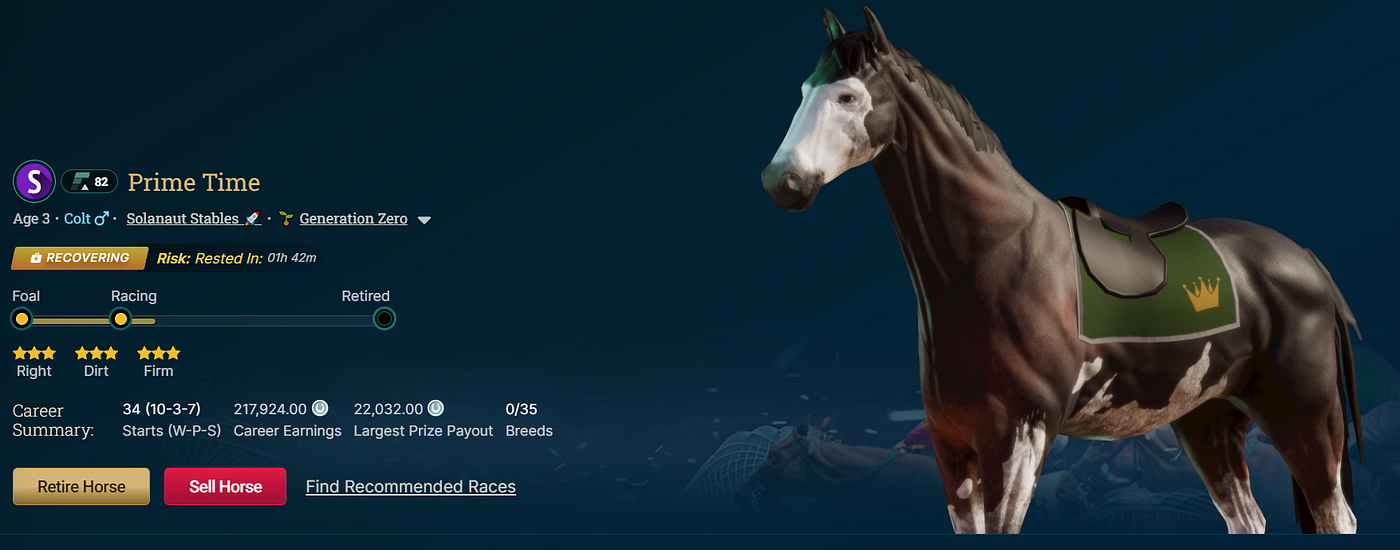
RT: Churro 3.3 PTF / Durban Poison 2.5 PTF / Cossack 5.0 PTF
LT: Ajax 4.2 PTF / Saturn 2.3 PTF / Bloodmoon 0.0 PTF
RD: Prime Time 2.9 PTF / Doc Holliday 2.2 PTF / Tony Rigatoni 0.3 PTF
LD: Eclipse 7.6 PTF / Spider from Mars 2.7 PTF / Rose of Zion 1.1 PTF
The lore of this game is going to be… beyond epic.
Glad to be on this ride with you all.
